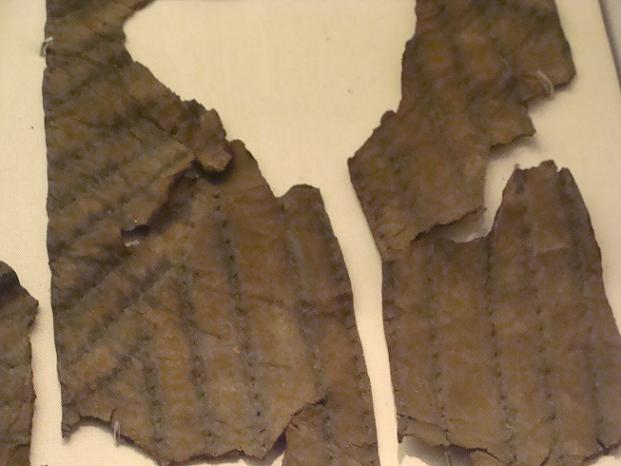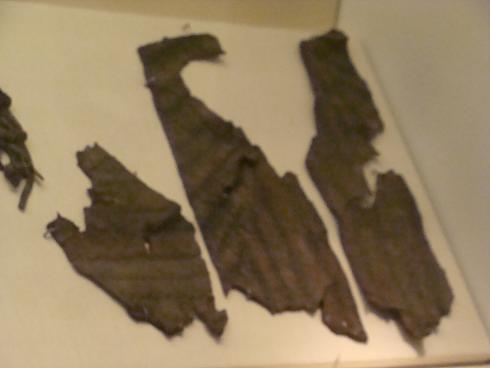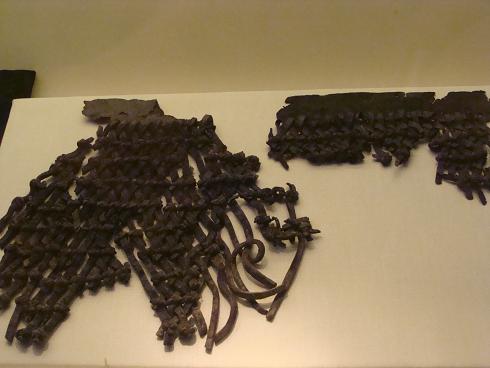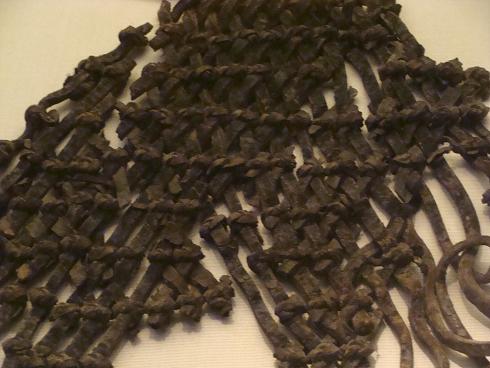Over the years that I have lurked and been on this site there have been numerous, often heated, discussions on the use of pre-12th century leather: armour, padding (gambeson/aketon), and clothing.
http://www.myArmoury.com/talk/viewtopic.php?p...ht=#151298
http://www.myArmoury.com/talk/viewtopic.php?t...highlight=
These topics have always ended rather indecisively. I have been traveling around and talking to different professors, curators, and archeologists; as well as examining different artifacts in museum store rooms, and private collections. Some of my findings have been very intriguing; almost “proof” of various forms of leather armour. I am writing an article on the use of pre-12th century leather armour, I figured I could give everyone here a chance to see some of my findings.
One of the biggest arguments against the use of a padded leather garment worn under maille is that there is no archeological evidence. There is. In the National Museum of Ireland, Dublin, there resides the remains of a c.1150-1190 quilted leather aketon* found at Cornmarket/Bridge St, Dublin (picture below).
In the Irish Tain Bo Cuailgne (10-11th century), Loeg, Cu Chulainn’s charioteer, is described wearing a deerskin tunic (inar), and mantle (bratt). Cu Chulainn is armoured thus:
“…twenty-seven tunics [cneslenti] worn next to his skin, waxed, board like, compact, which were bound with strings and ropes and thongs close to his fair skin…Over that outside he put his hero’s battle girdle [cathchriss] of hard leather, tough and tanned, made from the best part of seven ox-hides of yearlings, which covered him from the thin part of his side to the thick part of his arm-pit; he used to wear it to repel spears [gai] and points [rend] and darts [iaernn] and lances [sleg] and arrows [saiget], for they glanced from it as if they had struck against stone or rock or horn. Then he put on his apron [fuathbroic] of filmy silk with its border of variegated white gold, against the soft lower part of his body. Outside his apron of filmy silk he put on his dark apron [dond{f}uathbroic] of pliable brown leather made from the choicest part of four yearling ox-hides with his battle-girdle [cathchris] of cows’ skins about it.” (ibid., 11 2215ff)
In Germania (ch.17) Tacitus describes this:
“Tegumen omnibus sagum fibula aut, si desit, spina consertum: ceteraintecti totos dies iuxta focum atque ignem augunt. Locupletissimi veste disinguuntur, non fluitante, sicut Saramatae ac Parthi, sed stricta et singulos artus exprimente. Gerunt et ferarum pelles, proximi ripae neglegenter, ulteriores exquisisitius, ut quibus nullus per commercial cultus. Eligunt feras et detracta velmina spargunt maculis pellibusque beluarum, quas exterior Oceanus ataque ignotum mare gignit”
Which translates to…
“ The clothing for everyone is the cloak, which is fastened by brooch or failing that by thorn; they spend whole days at the fire by the hearth in nothing else. The greatest landowners are marked by clothes, not loose like the Sarmatians’ and Parthians’, but tight and shaping every limb. And they wear the skins of wild animals-- casually near the coasts, more carefully farther off as there is no trading culture. The animals are chosen, and the piebald coats are flayed and the skins of beasts which are born of the Outer Ocean and the unknown seas.”
In Vita Karoli (c.823-836 AD) Einhard writes:
“…and a jacket made of otter skin or ermine protected his shoulders and chest…”
If you find this interesting I do have others.
Best,
Hadrian
*aketon or gambeson (under maille)



